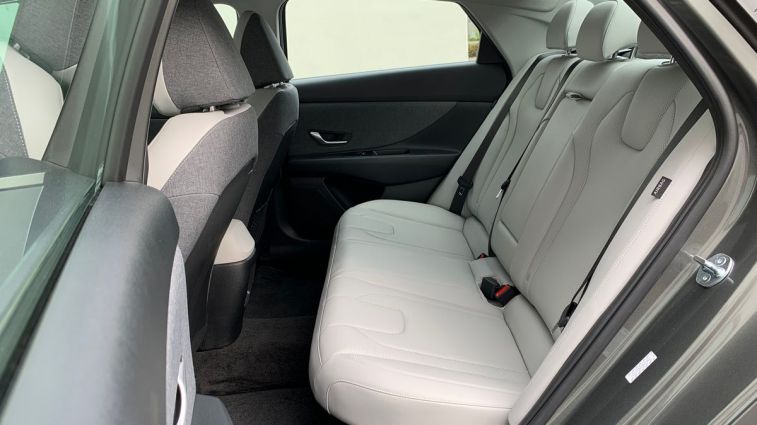- The 2025 Elantra has ample space, plenty of tech
- Pricing starts at $23,320 | Price it your way
- On sale now | See Elantra models on sale near you
The 2025 Hyundai Elantra is a compact sedan that competes with similarly fuel-efficient and budget-friendly rivals like the Honda Civic, Toyota Corolla, and Mazda3. For the 2025 model year, the Elantra sees some of its trim levels renamed, which we’ll get into later.
Safety remains a critical component of the Elantra, thanks in part to a steering wheel that provides haptic feedback when you’re, say, drifting out of your lane. In addition to lane-keeping assist, all Hyundai Elantra models boast blind-spot monitoring and a rear cross-traffic warning.
The Elantra is now available in five trims: SE, SEL Sport, SEL Limited, Limited, and N Line. All but the N Line comes with a 2.0-liter 4-cylinder engine that sends 147 horsepower to the front wheels via a continuously variable automatic transmission (CVT). The N Line comes with a 1.6-liter turbocharged 4-cylinder engine putting out 201 hp.
For even more performance, there is the range-topping Elantra N, a seriously sporty model that blasts down the road courtesy of a punchy 276-hp turbo 4-cylinder paired to either an 8-speed automatic or 6-speed manual transmission. Hyundai also offers an Elantra Hybrid that gets over 50 mpg in EPA combined fuel economy.
Let’s take a look inside the 2025 Hyundai Elantra.
Passenger Room and Comfort

Although the Hyundai Elantra is a compact car, it’s roomy enough for adults to be comfortable in both rows. The sloping roofline affects rear headroom a bit, but most folks fit back there just fine.
When it comes to ride and handling, the Elantra is a relaxed and comfortable means of getting from Point A to Point B. While it doesn’t have quite the athleticism of competitors like the Honda Civic and Mazda3, it’s still an agile accomplice. Plus, its compact size is appreciated in crowded cities and tight parking lots. Higher-performing versions like the Elantra N Line and the Elantra N are sprung noticeably firmer to match their higher-performance engines.
Features and Tech

Even though it starts at around $23,000, the Elantra comes with many desirable standard features. This includes an 8-inch touchscreen, wireless Apple CarPlay and Android Auto, keyless entry, and two USB ports.
A larger 10.25-inch touchscreen becomes available on the Elantra SEL Convenience model, though its smartphone connectivity is not wireless (as it is in the two lower trims). A wireless charging pad, a digital gauge cluster, and a Bose audio system are also offered starting with the Limited trim package.
The Hyundai Elantra boasts a wide range of standard driver aids, some of which are extra-cost options on cars costing thousands more. These include blind-spot monitoring with rear cross-traffic alert, automatic high-beam headlights, lane-keep assist, and safe-exit warning, to name a few.
Materials and Design
Hyundai has crafted a modern and classy cabin to match the Elantra’s bold exterior design. While there are some hard plastic trim pieces reminiscent of an economy car, the design of the interior is attractive. A lot of thought went into creating such an inviting and user-friendly space. The manually adjustable front seats in the lower trims are perfectly fine and supportive for routine driving duty. Limited and N Line trims get power-adjustable driver’s seats.
Most people will likely spring for the better-equipped Elantra SEL Convenience, which includes dual-zone climate control, push-button start, and the larger 10.25-inch touchscreen. If you opt for the top-of-the-line Limited, the highlights include genuine leather upholstery, the aforementioned power driver’s seat with lumbar support, ambient interior lighting, and a sunroof, all of which make the Elantra more upscale but still kind to most shopping budgets.
Cargo Room and Flexibility

At 14.2 cubic feet in capacity, the Elantra’s trunk is about average for a compact sedan. For comparison, the Toyota Corolla has a 13.1 cubic foot trunk, while the Honda Civic sedan has 14.8 cubic feet of trunk space.
The Elantra’s rear seat can be folded to create added space. A 60/40 split-folding rear seatback — helpful when you need extra cargo room but somebody is sitting in the back seat — becomes standard in the SEL Convenience trim, but isn’t even available the two lower trims.
Build and price your version of the Hyundai Elantra to see this week’s Fair Purchase Price. Browse Elantra models for sale near you.








